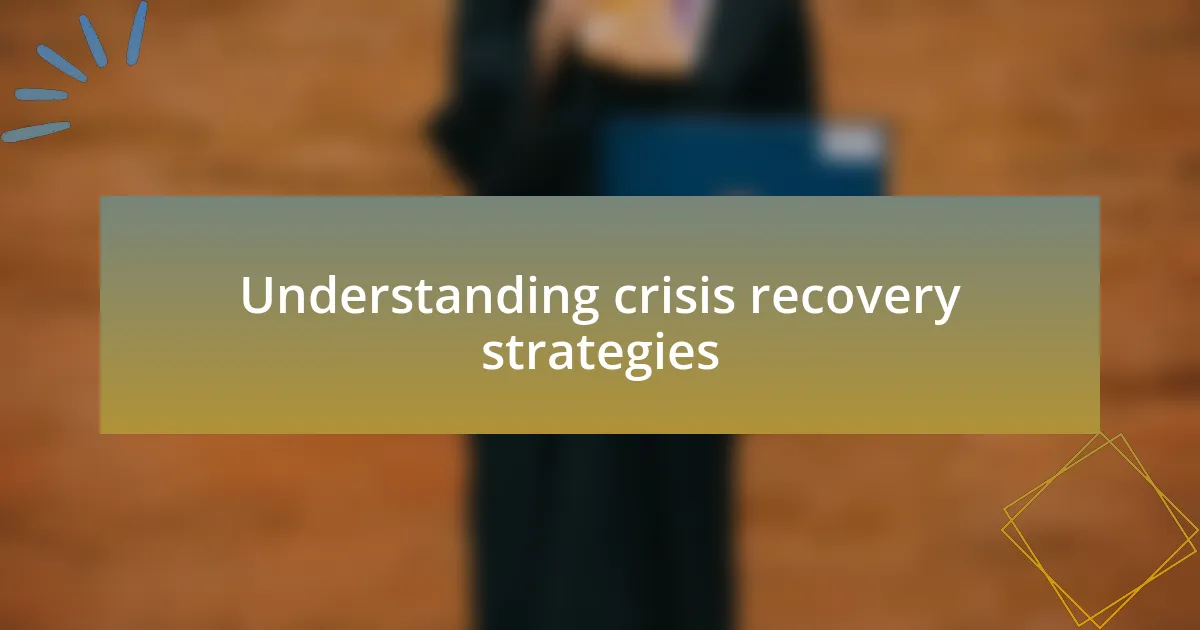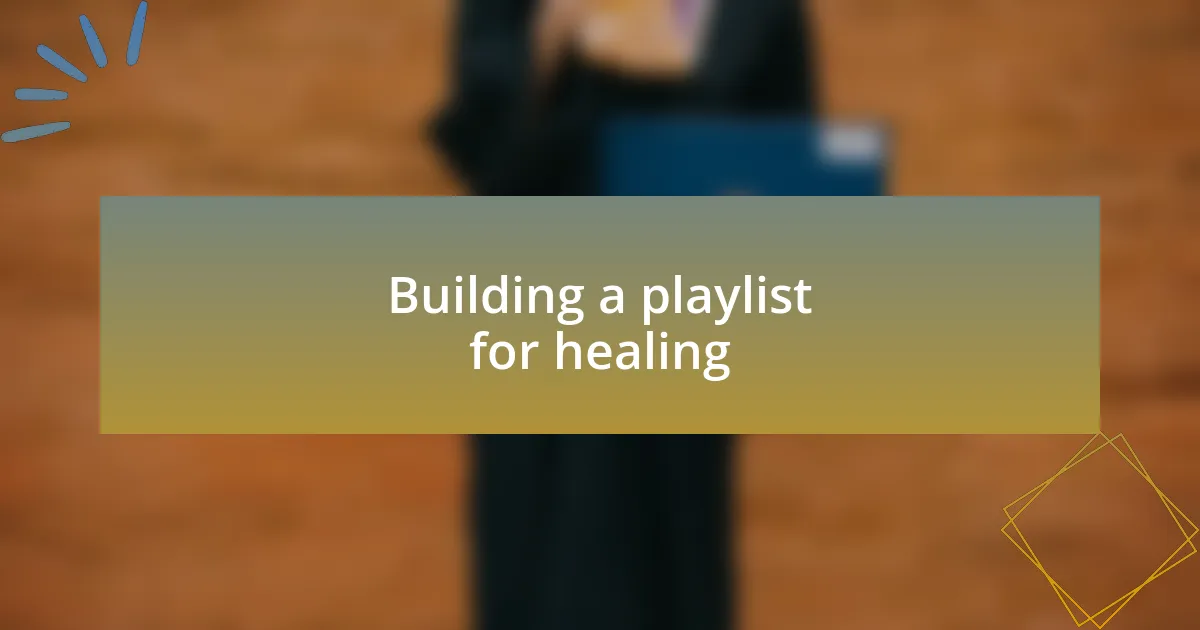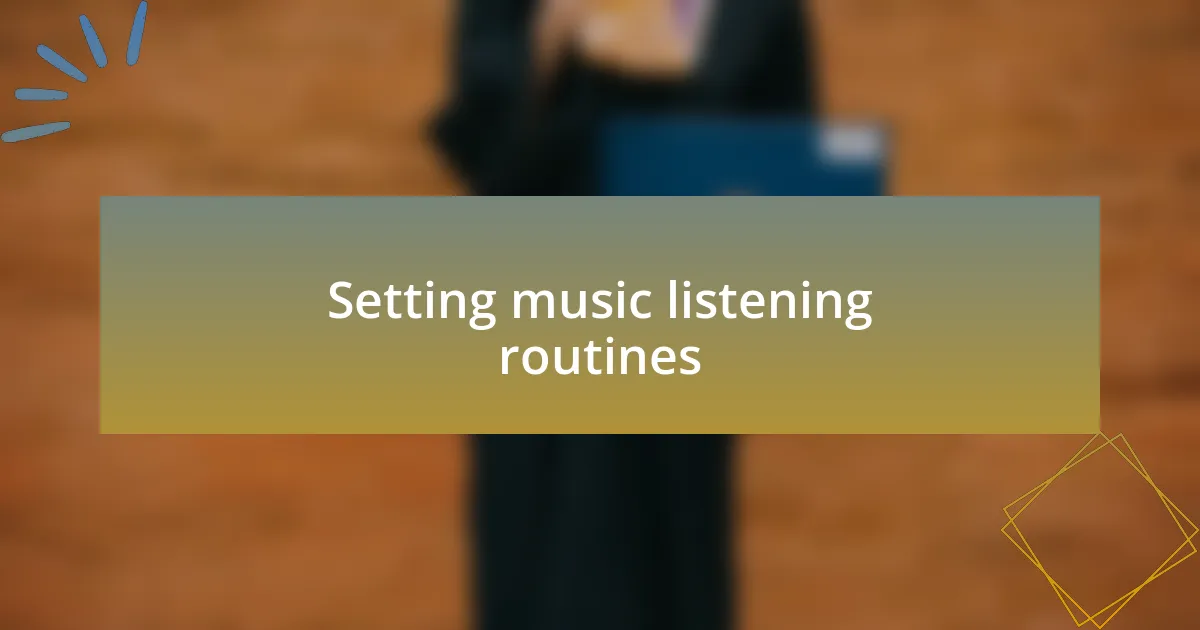Key takeaways:
- Creating a personalized playlist can facilitate emotional healing by resonating with one’s feelings and providing a sense of understanding.
- Music therapy and sharing music with others foster connection and community, aiding in the recovery process.
- Establishing a consistent music listening routine offers structure and can significantly impact emotional well-being during a crisis.
- Setting small, achievable goals post-crisis boosts confidence and helps navigate overwhelming situations effectively.

Understanding crisis recovery strategies
Crisis recovery strategies can vary widely, depending on individual circumstances and past experiences. I remember a time when my world felt overwhelming after a sudden setback. In moments like that, I often found solace in creating music; it became a therapeutic outlet that helped me articulate my feelings and regain my sense of control.
Have you ever considered how vital emotional support can be during challenging times? In my experience, connecting with friends who genuinely listen can facilitate healing. When I shared my struggles, their encouragement reminded me that I was not alone, and it opened pathways to resilience.
One strategy that stands out for me is setting small, achievable goals. After a crisis, it can be daunting to think about the bigger picture, but breaking tasks into manageable steps made a significant difference. Each time I accomplished one of those small goals, it gave me a little boost of confidence and hope, reinforcing my ability to overcome obstacles.

Personal experiences with music therapy
During one particularly challenging period, I discovered the power of music therapy in a profound way. I enrolled in a local music therapy group, not initially believing it would help, but the first time I sang my feelings aloud, something shifted inside me. It was as though the music lifted a weight I hadn’t even realized I was carrying, and I began to feel lighter.
I vividly recall a moment when I was surrounded by others in the group, each of us sharing our personal stories through song. Listening to their experiences resonated deeply with me; we were all navigating our unique paths of recovery. Isn’t it interesting how music can create a shared understanding that transcends words? In that setting, I found comfort and inspiration in knowing others were on similar journeys.
One time, during a vulnerable moment, I chose to play an original piece that reflected my struggles. The emotional release I experienced was cathartic. As I looked around, I saw tears in some eyes, and that connection solidified what I had come to understand: music therapy isn’t just about creating; it’s an avenue for healing shared experiences.

Building a playlist for healing
Building a playlist for healing can be an incredibly personal journey, one that requires thoughtful reflection on what truly resonates with you. When I faced a tough time, I started curating songs that mirrored my emotions, selecting those that made me feel understood and less alone. Do you ever find that one song just seems to capture everything you’re feeling in a single moment? I definitely did, and it made all the difference as I navigated my recovery.
One of the first tracks I added was an uplifting anthem that reminded me of resilience. Every time I played it, I felt a surge of strength. It’s remarkable how music can shift our perspectives. I often think, how can something so simple have such a profound impact? For me, each note was a stepping stone toward healing, encouraging me to keep moving forward even when the path felt overwhelming.
As I continued to build my playlist, I included songs that encouraged vulnerability—those slower ballads that prompted me to reflect and release my pent-up emotions. Each time I sang along, I could feel a wave of catharsis wash over me. It made me realize that the process of building this playlist wasn’t just about choosing songs; it was about creating a safe space for my heart to heal. Have you experienced that kind of connection with music, where every lyric speaks directly to your soul? It’s a powerful reminder of our shared human experience.

Setting music listening routines
Setting a music listening routine can be a vital part of navigating a crisis. I found that dedicating certain times of day to immerse myself in music brought a comforting structure to my routine. Whether it was a morning boost to kickstart my day or a soothing evening wind-down, these moments became a sanctuary. Have you ever noticed how a consistent listening time can turn songs into anchors?
I remember creating a ritual where I would settle into my favorite chair with a cup of tea and let my playlist envelop me in sound. This routine helped me disconnect from external distractions and truly experience the music. It’s amazing what a little bit of consistency can do; it transformed listening into a meaningful experience grounded in personal care. How often do we overlook the significance of setting our environments for deeper emotional connections?
As I established this music routine, I began to explore different genres that aligned with my emotional needs at various times. On those particularly challenging days, I would turn to classical pieces that offered serenity, while upbeat tracks served as a reminder of joy during moments of despair. Have you ever felt the shift in your mood just by changing the type of music you listen to? It’s incredible how flexible our music routines can be, adapting to our emotional landscapes and guiding us through both turbulence and tranquility.

Sharing music in recovery support
Sharing music in recovery support offers a platform for connection and healing. I recall a time when I participated in a group led by a friend, where we each took turns sharing a song that carried personal meaning. It was amazing to witness how everyone opened up, revealing pieces of themselves through the music they chose. Have you ever felt a bond grow stronger by simply discussing that one powerful song?
In addition, I found solace in sharing playlists with others who were navigating similar challenges. One particular playlist I shared included songs that provided hope and inspiration; it was a tangible way of saying, “You’re not alone.” When you see someone’s face light up because they recognize a song that resonated with them, it’s a reminder of the universal language we call music. How powerful is it to think that a simple melody can carry such weight in someone’s recovery journey?
Moreover, I’ve discovered how creating collaborative playlists fosters a sense of community. By inviting friends to contribute their favorite tracks, we inadvertently built a shared narrative filled with our diverse experiences and emotions. That combination of voices and stories is what makes the recovery journey feel less isolating. Have you experienced the collective power of music in a similar way? It truly shows that we can uplift each other, one song at a time.